Buying Guide for the Best Rollator Walkers
Choosing the right rollator walker is crucial for ensuring mobility, safety, and comfort. Rollator walkers come in various designs and with different features, so it's important to understand what each specification means and how it can affect your experience. By considering your specific needs and preferences, you can find a rollator walker that best suits you.Weight CapacityWeight capacity refers to the maximum weight that the rollator walker can safely support. This is important to ensure the walker can handle your body weight without compromising stability or safety. Rollator walkers typically have weight capacities ranging from 250 to 500 pounds. If you are on the heavier side, opt for a walker with a higher weight capacity to ensure durability and safety.
Height AdjustabilityHeight adjustability allows you to set the handle height to match your comfort level and posture. This is important for maintaining proper ergonomics and reducing strain on your back and shoulders. Rollator walkers usually offer adjustable handle heights ranging from 30 to 40 inches. Choose a walker that allows you to adjust the height to a level where your arms are slightly bent and you can walk comfortably.
Wheel SizeWheel size affects the rollator's maneuverability and ability to handle different terrains. Larger wheels (8 inches or more) are better for outdoor use and uneven surfaces, while smaller wheels (6 inches or less) are suitable for indoor use and smooth floors. Consider where you will primarily use the walker and choose a wheel size that matches those conditions.
Seat and BackrestThe seat and backrest provide a place to rest when you need a break from walking. This is important for comfort and convenience, especially if you plan to use the walker for extended periods. Look for a rollator with a padded seat and backrest that are comfortable and supportive. The seat height should also be appropriate for you to sit down and get up easily.
FoldabilityFoldability refers to the ability to collapse the rollator walker for easy storage and transport. This is important if you need to take the walker with you in a car or store it in a small space. Rollator walkers can be folded in different ways, such as side-to-side or front-to-back. Choose a walker that folds easily and compactly to fit your storage and transportation needs.
Braking SystemThe braking system ensures that the rollator walker can be securely stopped and parked. This is important for safety, especially on slopes or uneven surfaces. Rollator walkers typically have either loop brakes or push-down brakes. Loop brakes are operated by squeezing the handles, while push-down brakes are engaged by pressing down on the handles. Choose a braking system that you find easy to use and reliable.
Storage OptionsStorage options include baskets, pouches, or trays that allow you to carry personal items and essentials. This is important for convenience, especially if you need to keep things like medications, water bottles, or personal belongings within reach. Consider what items you need to carry and choose a rollator with adequate storage solutions that meet your needs.














